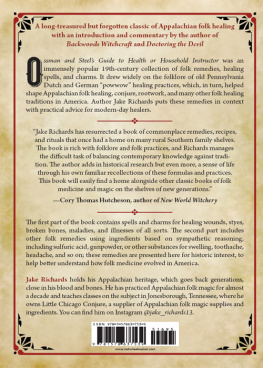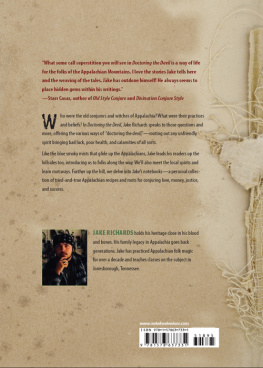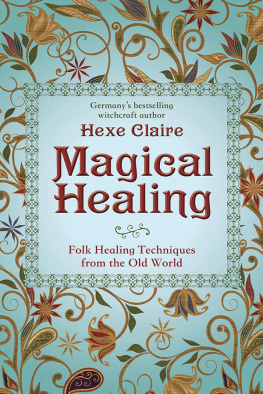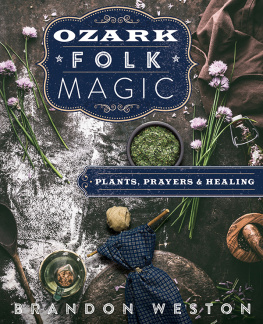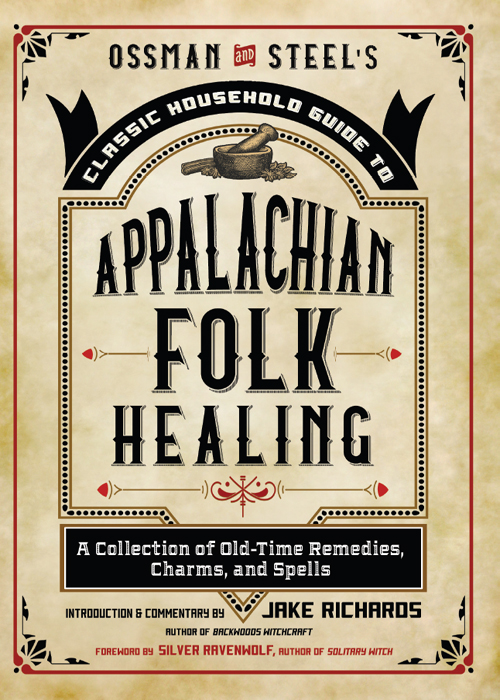
Praise for Ossman & Steel's Classic Household Guide to Appalachian Folk Healing
Jake Richards has given the folk magic community a gift by bringing back into circulation Ossman and Steel's collection of important remedies and prayers. Moreover, he has also provided the context for the work through his ongoing commentary. Richards allows the text to speak for itself while also giving explanations and insights from lived experience that fill in the blanks. For the many folks that have had the magic in their families buried or forgotten, this book provides a bridge that would otherwise be difficult to cross. There is both a familiarity in reading the contents, which speak to what many of us grew up hearing in whispers or snippets, as well as information that is likely to be new and aide in growing anyone's repertoire of folk magic. This book is likely to become a touchstone for many folk magicians, healers, and those living in the Appalachian diaspora looking to connect to these traditions.
Aaron Oberon, author of Southern Cunning
Jake Richards's annotated edition of Ossman & Steel's Classic Guide provides the rare opportunity to explore a scarce and culturally significant work on the ritual healing traditions of the Pennsylvania Dutch, who were influential throughout Appalachia. In the reverent voice of a contemporary practitioner, Richards guides readers through this classic healing manual, offering explanations and insights into the inner workings of this folk tradition. Ossman & Steel's Classic Guide is also the only known historical work of Pennsylvania Dutch ritual healing written by a mother and sonAnn Ossman and Isaac Steelunderscoring the traditional wisdom in valuing the contributions of both genders in the healing arts.
Patrick Donmoyer, author of
Powwowing in Pennsylvania
As a seasoned powwower in the manner of the Pennsylvania German Christian folk tradition, I have always been familiar with the Ossman and Steel work. It is a perfect example of how powwowing was welcomed by our southern neighbors and made workable by the slight alteration of rituals and charms to fit more closely with their southern Appalachian folk Christianity. I highly recommend to all students of folklore studies Jake Richards's updated Ossman & Steel's Classic Household Guide to Appalachian Folk Healing with commentary to add context to the rituals and charms. This work is important as it is a true testament of the state of historical folk magic in the Appalachians during the 19th and 20th centuries and has influenced the traditions of conjure and root work in Appalachian folk Christianity for nearly two hundred years.
Robert Matthew Phoenix, author of
The Powwow Grimoire

ALSO BY JAKE RICHARDS
Backwoods Witchcraft: Conjure & Folk Magic
from Appalachia
Conjure Cards: Fortune-Telling Card Deck and Guidebook
Doctoring the Devil: Notebooks of an
Appalachian Conjure Man

This edition first published in 2022 by Weiser Books, an imprint of
Red Wheel/Weiser, LLC
With offices at:
65 Parker Street, Suite 7
Newburyport, MA 01950
www.redwheelweiser.com
Copyright 2022 by Jake Richards
Foreword copyright 2022 by Silver RavenWolf
All rights reserved. No part of this publication may be reproduced or transmitted
in any form or by any means, electronic or mechanical, including photocopying,
recording, or by any information storage and retrieval system, without permission in
writing from Red Wheel/Weiser, LLC. Reviewers may quote brief passages.
ISBN: 978-1-57863-753-9
Library of Congress Cataloging-in-Publication Data available upon request.
Cover and text design by Sky Peck Design
Typeset in Arno Pro
Printed in the United States of America
IBI
10 9 8 7 6 5 4 3 2 1
www.redwheelweiser.com/newsletter

This book contains republished historical material that offers advice and information relating 19th-century healing remedies that contain herbs and other substances, some of which are harmful. It is not meant to diagnose, treat, or prescribe. It should be used to supplement, not replace, the advice of your physician or other trained healthcare practitioner. If you know or suspect you have a medical condition, are experiencing physical symptoms, or if you feel unwell, seek your physician's advice before embarking on any medical program or treatment. Some of the substances discussed in this book can be lethal if mishandled or ingested in sufficient quantities. Extreme caution is advised in their handling and use. Readers using the information in this book do so entirely at their own risk, and the author and publisher accept no liability if adverse effects are caused.

CONTENTS

FOREWORD
T he sweat ran.
The sun blazed.
They coughed in the swirls of sand and dirt. The convoy rumbled along a road of tire tracks on earth. Someone made a joke. Laughter. Shouts. A cacophony of ear-splitting sounds. Nostrils contracted and tear-filled eyes widened. Right hand immediately slapped to the chestsubconscious comfort at what lay beneath the uniform. Weapon in hand, she did her duty.
One minute he was walking across the compound toward the mess tent, and the next, he heard the bellow of, Incoming! He ran to shelter through billowing dust just as the bomb exploded right where he previously stepped. He let out a Ha! of relief, his fist immediately thumping his chest. Subconscious comfort at what lay beneath the uniform. Weapon in hand, he did his duty.
What do these two people have to do with this book? Why do we care that they touched a hand to chest, willing courage to blossom within themselves? What was it that lay beneath the uniform that others could not see?
Let's travel back in time to 1990, when a young woman, a harried mother of four, can't sit still in a wooden chair. She believes she is about to uncover yet another historical link in the chain of her research: work that weaves together the practice of using intelligent energy, prayer, therapeutic touch, and the power of the word into a unique system of energy healing. Of great interest is how this system of practice has traveled throughout the country and how this folk magick has changed with the influence of each practitioner, community needs, cultural influence, historical events, and eclectic personalities.
What this mother looks for today is a chapbook published in 1894 out of Wiconisco, Pennsylvania, a small township in the rural coal country of Dauphin County. Wiconisco and the surrounding areas were harnessed with low pay and difficult living conditions resulting from the area's primary industrycoal mining. Needs and desires of the common folk birthed this chapbook: the hope of good health, good fortune, happy marriage, and a long life free of anxiety and trouble. Her interest is two-fold: How the practice of Braucherei flowed with the movement of the people, settling where it was most needed, and how it was embraced by mining families as well as farming families.
Next page
